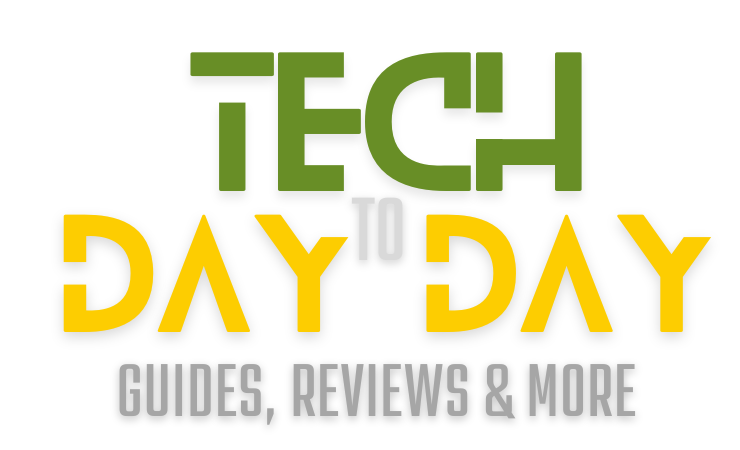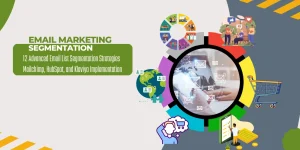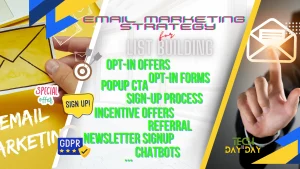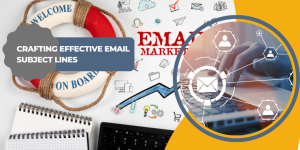In the age of rapid technological advancements and an overwhelming number of communication platforms, email remains a resilient and effective channel. Its journey from being a simple electronic message transfer system in the early ’70s to today’s sophisticated marketing tool is truly remarkable. Over the decades, it has survived the rise of social media, instant messaging apps, and other digital communication forms, retaining its importance in the professional and marketing worlds.
Table of Contents
Email Marketing in 2023: Still Relevant?
Some might question: with the prevalence of newer platforms and technologies, is email marketing still relevant in 2023? The answer is a resounding yes.
Here’s why:
- Reach: Even today, almost everyone has an email account. With over 4 billion email users globally, the reach is extensive, more than any social media platform.
- Personalization: Unlike other platforms, emails can be highly personalized. Advanced tools and AI capabilities of 2023 have further refined this, allowing marketers to tailor content specifically to the recipient’s behavior and preferences.
- Cost-effective: One of the biggest advantages of email marketing is its cost-effectiveness. For every dollar spent, the average return on email marketing investment is about $42.
- Control: Platforms like social media are controlled by algorithms that determine content reach. With emails, you have more control over who sees your content and when.
- Embracing the Future: While email marketing’s core principles remain, 2023 has brought with it new trends, tools, and best practices that marketers must adapt to. From integrating augmented reality to focusing on sustainability, email marketing is evolving, and so must our strategies.
In this guide, we aim to demystify the complexities of email marketing in 2023. Catering to both veterans and newcomers, we strive to present a comprehensive overview, ensuring your campaigns thrive in today’s dynamic marketing environment.
The Basics of Email Marketing
After understanding the essence of email marketing, lets see its distinct categories. Not all emails serve the same purpose, and recognizing these variations is paramount to crafting successful campaigns. Let’s dive into two primary types: transactional and promotional emails, and discern their unique characteristics.
Defining Email Marketing
At its core, email marketing is the use of email to promote products, services, or convey messages to an audience. Unlike personal emails, it is a strategic blending of visuals, content, and calls-to-action, all tailored to engage recipients and prompt them to take a desired action. Whether it’s to read a blog post, buy a product, sign up for a webinar, or simply stay updated with company news, email marketing serves various purposes.
Transactional vs. Promotional Emails
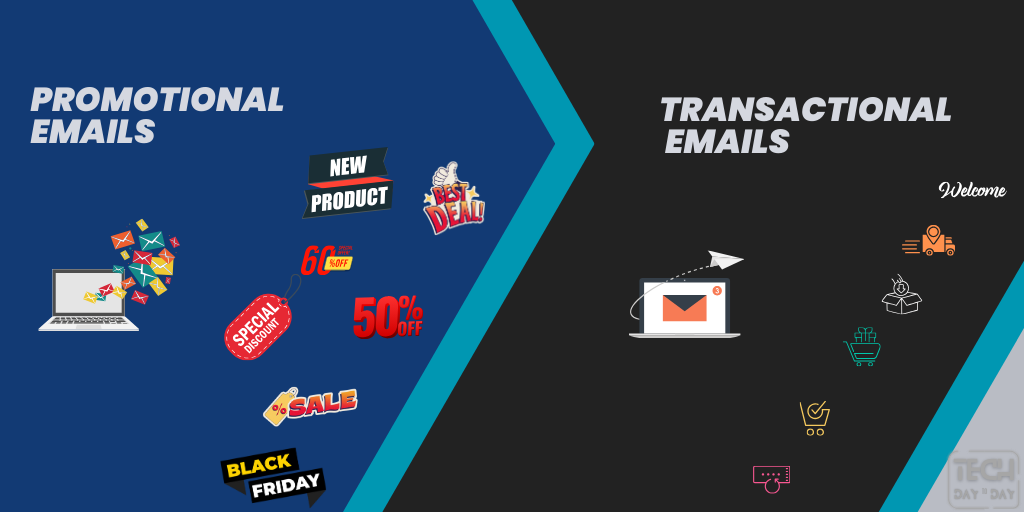
Understanding the distinction between these two is crucial:
- Transactional Emails: These are triggered by a user’s action and are personalized to them. Examples include:
- Order confirmations
- Shipping notifications
- Password reset emails
- Welcome emails after signing up
- Promotional Emails: Aimed at promoting a product, service, or content. They are less personalized compared to transactional emails but are tailored based on segmented audience interests.
- Sales or discount offers
- Product launch announcements
- Newsletters with curated content
The Power of Direct Communication
One of the main reasons email marketing stands out is its directness. Unlike social media posts that appear on timelines and might be overlooked, emails land directly in a user’s inbox, granting marketers a more personal space to communicate. The key lies in ensuring the email is relevant, timely, and valuable, making the recipient more likely to open and engage.
As simple as it may seem, email marketing is a multifaceted strategy with its set of rules and best practices. As we move forward, we’ll dive deeper into strategies to optimize and harness the full potential of your email campaigns.
Understanding Your Audience for Email Marketing
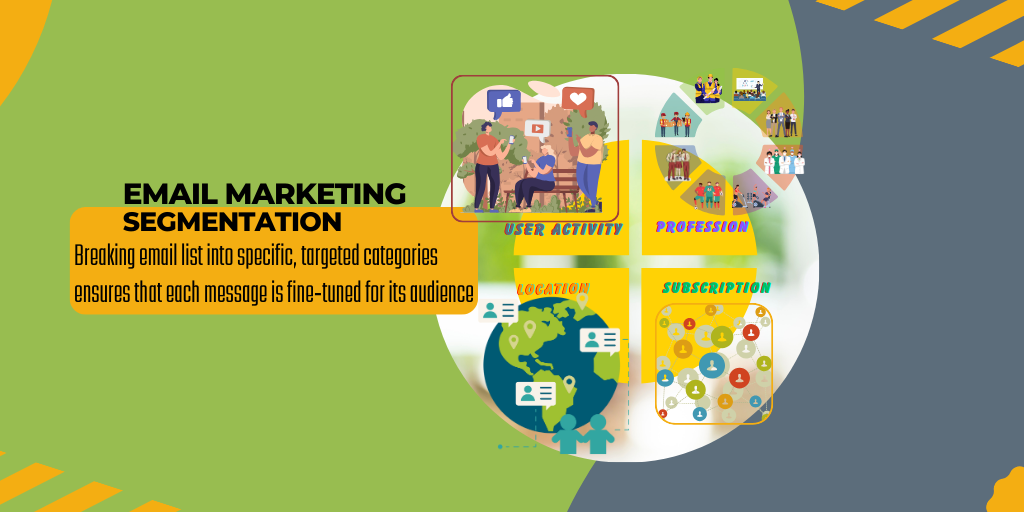
Know Who You’re Talking To
In the realm of email marketing, the first step isn’t crafting your message—it’s truly understanding who’s on the other end. It’s not just about having an email list but truly grasping what drives, interests, and engages each recipient.
The Precision of Segmentation
Breaking your email list into specific, targeted categories ensures that each message is fine-tuned for its audience. This isn’t just good practice; it’s essential for relevance.
Criteria for Segmentation:
- Demographics: Such as age, profession, or location.
- User Activity: Like purchase history or website interactions.
- Engagement Metrics: Assessing how often they interact with your emails.
- Subscription Duration: Differentiating newcomers from long-term subscribers.
Example: Consider a fitness brand. Their younger audience might receive content about high-intensity workouts, while the older segment might get information on joint health and mobility exercises.
Leveraging Modern Tools
The email marketing toolkit in 2023 is vast and invaluable. Make it a point to:
- Seek Direct Input: Use surveys or feedback mechanisms to get straight from the source insights.
- Utilize Analytics: Determine which content works and what doesn’t by assessing open and click rates.
- Integrate with CRM Systems: Centralize and effectively use customer data to refine your approach.
Example: By integrating with a platform like Google Analytics, you can pinpoint which products or articles your email recipients gravitate towards, shaping your future strategies.
As we navigate email marketing, knowing your audience isn’t a plus—it’s a prerequisite. Through smart segmentation and the right tools, every email becomes more impactful, fostering better engagement and results.
Crafting Compelling Email Content

Start with a Strong Subject Line
The first point of contact with your recipient is the subject line.
In a sea of emails, this can be the difference between being opened or ignored. Given the advancements and trends in Email Marketing, a catchy yet relevant subject line is more critical than ever.
Example: For a holiday sale email, instead of “Big Sale Now On!”, try “Unwrap Your Exclusive Holiday Discounts! 🎁”.
Prioritize Personalization
Every subscriber wants to feel valued. Leveraging data to address recipients by their first name or referring to their past interactions can elevate the entire email experience. This isn’t just about using their name; it’s about curating content that aligns with their preferences and behaviors.
Example: For a book store’s email marketing campaign, sending personalized reading recommendations based on past purchases: “John, based on your love for mystery novels, you might enjoy this new release!”
Keep it Visual but Relevant
Visual elements can break content monotony, making emails more engaging. However, they should be relevant to the message and not just added for aesthetic appeal. With the rise of interactive and dynamic content in Email Marketing, visual elements are not just images but also GIFs, videos, and interactive widgets.
Concise and Clear Messaging
In today’s fast-paced digital environment, brevity is key. Ensure your emails are clear, concise, and straight to the point, making it easier for recipients to grasp your message quickly.
Example: Instead of “Our company is thrilled to inform our esteemed customers about an upcoming sale event where products across various categories will be available at significantly reduced prices”, use “Exciting news! Our big sale is coming – enjoy huge discounts across all categories.”
End with a Clear Call-to-Action (CTA)
Every email should guide the recipient towards a desired action, be it reading a blog, making a purchase, or filling out a survey. A clear and compelling CTA is essential to guide this user action.
Example: For a webinar invitation: Instead of a simple “Click here”, use “Secure Your Webinar Seat Now!”
Crafting content for Email Marketing requires a blend of creativity, personalization, and clarity. It’s about understanding the recipient’s needs, grabbing their attention, and providing value in every interaction. By keeping content tailored, visual, and to the point, email marketers can ensure higher engagement and response rates.
Strategies for Efficient Email Deliverability

The Importance of Deliverability
Achieving success in Email Marketing goes beyond crafting compelling content. It’s vital to ensure that your emails actually reach your recipients’ inboxes and don’t end up in the dreaded spam folder. Deliverability isn’t just about sending emails; it’s about ensuring they land in the right place.
Authenticate Your Emails
Using authentication methods like SPF (Sender Policy Framework), DKIM (DomainKeys Identified Mail), and DMARC (Domain-based Message Authentication, Reporting, and Conformance) can significantly increase the trust email servers have in your messages, ensuring higher deliverability rates.
Example: Think of email authentication like a passport check at an airport, confirming the legitimacy of the traveler. In the same way, authentication confirms the legitimacy of the email sender.
Regularly Clean Your Email Lists
Maintaining a clean and updated list ensures you’re only sending emails to people who are genuinely interested. Remove bounced email addresses, unsubscribed users, and those who haven’t engaged in a long time.
Avoid Spam Trigger Words
Certain words and phrases can flag emails as spam. Be cautious about using words like “free”, “guarantee”, or “no obligation”. It’s essential to be aware of these triggers in Email Marketing to maintain optimal deliverability.
Example: Instead of writing “Get your FREE trial now!”, consider “Try our service at no cost.”
Maintain a Consistent Sending Frequency
While it’s tempting to send multiple emails during promotional periods, maintain a balanced frequency. Sending too many emails can deter subscribers and negatively impact deliverability.
Example: If a brand usually sends bi-weekly newsletters, suddenly bombarding subscribers daily during a sale might lead to increased unsubscribe rates.
Engage with Engaging Content
Ensure that the content you’re sending encourages interaction. High engagement rates can boost your sender reputation and consequently improve deliverability. Regularly review which content gets the most clicks and opens, and use this data to guide your strategy.
Responsive Design
With a significant portion of users accessing emails on mobile devices, tablets, and various desktop screen sizes, it’s crucial that your email layouts adjust seamlessly to provide an optimal viewing experience. A responsive email design ensures that whether your recipient is checking their email on a smartphone during their commute, a tablet at home, or their desktop at work, your message is clear, accessible, and engaging. It not only enhances the user experience but also improve the likelihood of interaction and conversion.
Monitoring Feedback Loops
Feedback loops, offered by many ISPs, notify senders when a recipient marks an email as spam. By tracking these notifications, marketers can identify and address potential issues in their content, maintain a reputable sender status, and fine-tune their strategies. Proactively managing and responding to feedback ensures that your emails remain welcome in inboxes, safeguarding your campaign’s effectiveness and your brand’s integrity.
Navigating Email Marketing requires more than just sending messages. Ensuring emails land in the desired destination and are read by the target audience is crucial. By implementing the right deliverability strategies, marketers can optimize the effectiveness of their campaigns and foster genuine connections with their audience.
Measuring Success

Why Metrics Matter
In the evolving landscape of Email Marketing, understanding and measuring success is crucial. Without proper metrics, marketers are sailing blind. Metrics provide tangible insights, allowing for iterative improvements in strategy and content.
Open Rate – The First Indication
The open rate gives an initial understanding of how well your email campaigns are being received. It measures the percentage of recipients who opened the email, giving an indication of the effectiveness of subject lines and send times.
Example: An open rate of 20% on a 1000 subscriber list means 200 recipients opened the email.
Click-Through Rate (CTR) – Engagement Metric
CTR is a critical metric as it tells you the percentage of email recipients who clicked on one or more links in an email. This gives insights into the effectiveness of the content and CTAs within the email.
Example: A CTR of 10% on the previous 1000 subscriber list means 100 recipients clicked a link in the email.
Conversion Rate – Ultimate Goal Tracking
While clicks are great, conversions are where the real value lies. The conversion rate tracks the percentage of recipients who clicked on a link and completed a desired action, such as making a purchase or signing up for a webinar.
Example: If 50 of the previous 100 recipients who clicked made a purchase, the conversion rate would be 50%.
Bounce Rate – Delivery Effectiveness
This measures the percentage of your total emails sent that could not be delivered to the recipient’s inbox. A high bounce rate can be detrimental to your sender reputation, making it a crucial metric to monitor.
Example: If out of 1000 emails sent, 50 couldn’t be delivered, the bounce rate would be 5%.
Unsubscribe Rate – Audience Feedback
While no marketer likes seeing subscribers go, the unsubscribe rate is an essential feedback mechanism. It indicates the percentage of recipients who opted out of receiving future emails.
Example: If 10 out of the 1000 subscribers chose to unsubscribe after an email, the unsubscribe rate would be 1%.
Forward/Share Rate
This measures the percentage of recipients who share your email content with others or forward the email itself. This metric is a strong indicator of the quality and relevance of your content, as it highlights messages that resonate enough with recipients to prompt sharing. A higher forward/share rate not only amplifies your reach but also signifies increased engagement and trust in your content.
Overall ROI (Return on Investment)
Overall ROI is a pivotal metric that quantifies the profitability of your email marketing campaigns. By comparing the revenue generated from your emails to the cost of running these campaigns, you can assess the financial effectiveness of your strategies. A positive ROI indicates a successful campaign, while a negative one signals the need for adjustment. It’s a clear, bottom-line indicator of the tangible value email marketing brings to your business.
Metrics are the compass guiding Email Marketing strategies. They provide a quantitative assessment of campaigns, facilitating informed decisions and strategy refinements. As email marketing continues to evolve, a keen understanding and interpretation of these metrics are paramount to achieve and sustain success.
Adapting to Email Marketing Trends

The Dynamic Nature of Email Marketing
The digital landscape is ever-evolving, and Email Marketing is no exception. To stay ahead of the curve, it’s imperative to recognize, understand, and adapt to emerging trends, ensuring your strategies remain fresh and effective.
Interactive Content – Beyond Static Emails
Interactive elements, such as embedded videos, quizzes, or surveys, have become increasingly popular. They provide a richer experience for recipients, driving higher engagement and conversions.
Example: A fashion brand embedding a mini lookbook video within the email, allowing subscribers to see the latest collection in action.
AI-Powered Personalization
Harnessing the power of Artificial Intelligence allows for hyper-personalization in email marketing. AI can analyze vast amounts of data quickly, enabling marketers to send content tailored to individual subscriber preferences, behavior, and history.
Example: AI analyzing a subscriber’s browsing behavior and purchase history to curate a list of recommended products in the next email.
Voice Assistants and Email
With the rise of voice assistants like Siri, Alexa, and Google Assistant, there’s an emerging trend of people checking their emails via voice. Ensuring your emails are voice-friendly, with clear and concise content, will become increasingly important.
Example: Avoiding complex jargons and focusing on straight-to-the-point content to facilitate smooth reading by voice assistants.
Mobile-First Design
Given the ubiquitous nature of mobile devices, designing emails that are mobile-responsive is no longer optional. It’s a necessity. In Email Marketing, the emphasis is on a mobile-first approach, ensuring content looks impeccable on smaller screens.
Example: Using single-column layouts, larger fonts, and easily clickable buttons optimized for mobile viewing.
Enhanced Privacy and Regulations
With increasing concerns about data privacy and the introduction of stringent regulations, transparency and compliance have become paramount. Marketers must ensure they’re not only collecting data ethically but also using it responsibly.
Example: Always including clear unsubscribe options in emails and being transparent about data usage in line with regulations like GDPR and CCPA.
Visual Storytelling
Visual storytelling in email marketing is more than just adding images or graphics; it’s about weaving a cohesive and engaging narrative through visuals that resonate with the audience. As recipients skim through their inboxes, emails that can convey messages succinctly and evocatively through visuals have a higher chance of grabbing attention and driving engagement.
Case in Point: Nike’s “Just Do It” Campaign Emails Nike often crafts its emails around individual stories of athletes or everyday people overcoming challenges. An email might begin with a gripping image of a marathon runner, sweat glistening, determination evident. As you scroll, the visuals transition from the runner’s early struggles to crossing the finish line, all supported by minimal yet impactful text. This narrative through visuals makes the recipient not just see, but feel the journey, evoking emotions and connecting them deeply with the brand.
Sustainability Focus
As global awareness about environmental issues grows, consumers are increasingly leaning towards brands that showcase eco-consciousness. Integrating a sustainability focus in email marketing campaigns not only demonstrates a brand’s responsibility but also resonates with the values of many modern consumers. Whether it’s promoting eco-friendly products, sharing green initiatives of the company, or just offering eco-tips, such messaging can foster a deeper connection with recipients who prioritize sustainability.
Case in Point: Patagonia’s “Don’t Buy This Jacket” Campaign Emails A few years ago, Patagonia sent out an email during the holiday shopping frenzy with the bold statement, “Don’t Buy This Jacket.” The email showcased the environmental cost of one of their best-selling jackets. Instead of pushing for sales, they advocated for responsible consumption and encouraged buyers to consider the environmental impact of their purchases. This honest, sustainability-centric approach garnered immense respect and trust from their audience, demonstrating the power of aligning with eco-conscious values in email marketing.
The tapestry of Email Marketing is woven with innovation, technology, and an unwavering commitment to delivering value to subscribers. Adapting to emerging trends ensures marketers remain in step with their audience’s expectations, optimizing engagement and results in an ever-shifting digital landscape.
Best Tools for Email Marketing

Tool Selection in the Modern Marketing Era
As Email Marketing strategies become more sophisticated, the tools at a marketer’s disposal need to keep pace. From automation to analytics, the right toolkit can elevate your email marketing efforts, driving enhanced engagement and conversions.
Email Marketing Platforms
These platforms form the foundation of your email marketing campaigns, providing features like list management, campaign creation, and performance tracking.
Example: Mailchimp is a robust platform catering to both small businesses and larger enterprises. It offers automation, segmentation, and detailed analytics.
Email Design and Testing Tools
Email design can make or break your campaign. Testing tools ensure that your design is responsive across devices and email clients.
Example: Litmus allows marketers to preview email designs across various devices and email clients, ensuring a consistent look and feel.
Automation and Segmentation Tools
Automation tools enable marketers to send emails at optimal times, segment their audience for targeted campaigns, and nurture leads through the funnel without manual intervention.
Example: HubSpot offers robust automation capabilities, allowing for detailed customer journeys based on behavior, preferences, and previous interactions.
Analytics and Reporting Tools
Beyond sending emails, understanding their performance is crucial. These tools provide insights into open rates, CTRs, conversions, and more.
Example: Campaign Monitor not only allows for email dispatch but also offers detailed post-campaign analytics, giving insights into what worked and what needs tweaking.
List Building and Management Tools
Growing and managing your subscriber list is fundamental. These tools help collect new subscribers, segment them, and ensure the list remains clean and updated.
Example: OptinMonster is a powerful tool to grow your email list, allowing for the creation of eye-catching opt-in forms and offering features like exit-intent technology.
The Email Marketing landscape is complex, but with the right tools, marketers can streamline processes, enhance engagement, and ensure consistent success. Investing in and mastering these tools is essential for anyone serious about capitalizing on the power of email marketing in the modern age.
For a deeper dive into each of these tools and more comprehensive recommendations, be sure to check out our dedicated article: Maximizing Marketing Potential: The Crucial Role of Email Marketing Tools in the Modern Digital Landscape
Final Thoughts on Mastering Email Marketing
The Constant Evolution of Email Marketing
As with all facets of digital marketing, Email Marketing is not static. It’s an evolving domain, where today’s best practices may become obsolete tomorrow. Staying ahead requires marketers to be adaptable, proactive, and ever-curious.
Adaptability is Key
The tools, strategies, and trends in email marketing change, but the core principle remains: delivering value to the subscriber. This can only be achieved by those who are willing to adapt, learn from their metrics, and pivot their strategies accordingly.
Example: Brands that once relied heavily on promotional emails are now seeing better engagement by mixing in educational content, storytelling, and interactivity.
Building Genuine Relationships
In the era of Email Marketing, it’s not just about numbers—open rates, CTRs, or conversion rates. It’s about building genuine, lasting relationships with subscribers. Authenticity, trustworthiness, and consistency in communication lay the foundation for this bond.
Example: A brand sending personalized birthday wishes or anniversary discounts, showing subscribers they’re valued and remembered.
Always Prioritize Value Over Volume
It can be tempting to flood subscribers with content, hoping something sticks. However, in 2023, it’s quality over quantity. Tailored, valuable content will always outperform generic mass emails.
Example: Instead of daily promotional emails, brands can opt for weekly digests, curating the most valuable information or offers for their subscribers.
Continuous Learning and Upgrading
The world of Email Marketing offers numerous resources—webinars, courses, workshops, and articles. Marketers should always be on the lookout for opportunities to enhance their skills and knowledge.
Mastering Email Marketing in 2023 goes beyond techniques and tools. It’s about understanding your audience, building genuine relationships, and consistently delivering value. As we navigate the dynamic waters of email marketing, always remember: it’s the connection with the subscriber that truly counts.
For those keen on diving deeper into the specifics of tools and strategies, our detailed guide on Maximizing Marketing Potential: The Crucial Role of Email Marketing Tools in the Modern Digital Landscape is a must-read.
Tips to Boost Your Email Marketing ROI
Introduction to ROI in Email Marketing
In the ever-competitive digital landscape, achieving a substantial return on investment (ROI) is the goal of every marketer. When it comes to Email Marketing, the emphasis is on effective strategies that deliver tangible results.
1. Segment Your Audience
Understanding and segmenting your audience allows for more personalized and relevant communication. Tailoring content based on demographics, behavior, or past purchases can significantly enhance engagement.
Example: An online bookstore sending personalized reading recommendations based on a subscriber’s past purchases.
2. A/B Test Regularly
Consistent A/B testing of subject lines, email content, or call-to-action buttons provides insights into what resonates best with your audience. This iterative approach ensures optimization over time.
Example: Testing two subject lines – “Unlock Your Exclusive Offer!” vs. “Special Discount Just for You!”
3. Optimize for Mobile
With the majority of emails now being opened on mobile devices, a mobile-responsive design isn’t optional—it’s essential. Ensure fonts, images, and CTA buttons are optimized for mobile viewing.
Example: Adapting a multi-column email layout to a single column for seamless mobile experience.
4. Implement Automation
Automating email campaigns, especially for cart abandonment or welcome sequences, can drive consistent engagement without constant manual effort.
Example: Setting up an automated series of three emails for users who’ve added products to their cart but haven’t completed the purchase.
5. Focus on Deliverability
Ensuring your emails reach the recipient’s inbox and not the spam folder is crucial. Maintain a clean email list, use trusted platforms, and avoid spam-triggering words in your content.
Example: Regularly updating your email list to remove inactive subscribers or those who’ve opted out.
6. Value-Driven Content
Prioritize content that offers real value to your subscribers. Whether it’s exclusive discounts, educational content, or industry insights, always focus on the recipient’s interests.
Example: A B2B company sharing monthly industry reports or whitepapers exclusive to their email subscribers.
7. Monitor and Analyze Performance Metrics
Beyond open rates, delve deep into metrics like click-through rates, conversion rates, and email sharing rates. These insights can guide future strategies.
Boosting ROI in Email Marketing requires a blend of strategic insight, adaptability, and consistent focus on delivering subscriber value. By incorporating these tips into your email marketing playbook, not only will you witness improved engagement but also a noteworthy enhancement in your campaign returns. Stay informed, stay agile, and keep connecting.
The Future of Email Marketing Beyond 2023
Peering into the Digital Horizon
The realm of Email Marketing is just a snapshot in the continuously evolving digital landscape. As we look forward, several emerging trends promise to shape the email marketing world in the coming years.
1. Integration of Advanced AI and Machine Learning
Artificial Intelligence (AI) and Machine Learning (ML) are poised to offer unprecedented personalization and automation capabilities in email marketing.
Example: Predictive analytics might suggest the optimal content for a user even before they know they’re interested, based on their digital behavior.
2. Rise of Interactive Emails
Beyond static images and text, the future holds a promise for emails that are mini-applications in themselves. Think of integrated polls, surveys, or even shopping experiences directly within the email.
Example: An email from a clothing brand allowing users to view a 360-degree model of a product, select sizes, and make a purchase without leaving the email.
3. Enhanced Security and Privacy Measures
As cyber threats become more sophisticated, the emphasis on security in email marketing will rise. Enhanced encryption methods and stricter privacy regulations will become the norm.
Example: Adoption of advanced encryption methods to ensure that user data within emails remains confidential.
4. Voice Activated Email Interactions
With voice search and voice-activated devices gaining traction, future emails might be designed for voice-first interactions.
Example: Users asking their smart devices to read out promotional offers from their email or instructing devices to archive or categorize emails using voice commands.
5. Sustainability and Ethical Marketing
The growing global emphasis on sustainability will reflect in email marketing. Brands will opt for ethical marketing practices, promoting sustainable products and showcasing their eco-friendly initiatives.
Example: A brand promoting its shift to sustainable packaging in its email campaigns, or emphasizing products made from recycled materials.
The future of email marketing is a blend of advanced technology, enhanced user experiences, and a conscious shift towards ethical and sustainable practices. For businesses and marketers, staying abreast of these trends will be essential. While Email Marketing 2023 offers a plethora of insights and best practices, looking beyond, to the horizon, will ensure longevity and success in this domain. Embrace the future, but do so with adaptability and a commitment to value for your subscribers.
Conclusion and Key Takeaways
Wrapping Up the Email Marketing Journey
As we conclude our guide to mastering Email Marketing, it’s evident that this digital marketing strategy, while well-established, is far from static. As technology, user behaviors, and global trends evolve, so must our approach to connecting with subscribers.
Key Takeaways:
1. Subscriber-Centric Approach
Always place your subscribers at the center of your strategy. Understand their preferences, needs, and behaviors to craft meaningful interactions.
2. Evolve with Trends
From the increasing emphasis on AI and ML to the shift towards interactive emails, staying updated with the latest trends is non-negotiable.
3. Prioritize ROI and Value Delivery
Every email sent should offer clear value, both to the subscriber and in terms of ROI. From segmenting your audience to A/B testing, employ strategies that amplify results.
4. Security and Ethics Take Center Stage
With growing concerns around data privacy and ethical marketing, brands should emphasize transparent, secure, and ethical communication.
5. Embrace the Future, but Retain the Human Touch
While technology will undoubtedly play an even larger role in email marketing’s future, the human connection should never be overlooked. Authenticity, genuine relationships, and trust remain at the core of successful email marketing campaigns.
Final Words
Email Marketing is a testament to the enduring relevance of email in the digital age. However, mastery demands continuous learning, adaptability, and a genuine commitment to delivering value. As you venture forward, let this guide be your compass, and always prioritize the connection with your audience. The future of email marketing is bright, filled with opportunities and innovations, and it beckons to those ready to embrace its potential.
FAQ: Navigating the Complexities of Email Marketing
In our journey through the intricacies of Email Marketing, several common questions have emerged. Here’s a consolidated FAQ section addressing those queries, helping you further demystify the domain.
1. How has AI and ML changed the landscape of email marketing?
Artificial Intelligence and Machine Learning have revolutionized email marketing by enabling hyper-personalization, predictive analytics, and automating manual processes, ensuring a more targeted and efficient approach.
2. What are interactive emails?
Interactive emails refer to emails that allow users to engage with content directly within the email. Examples include embedded surveys, carousel images, and even shopping experiences without leaving the email environment.
3. How do I ensure the security of my email marketing campaigns?
Prioritize using platforms that emphasize end-to-end encryption, regularly update your cybersecurity protocols, and remain informed about the latest security threats and mitigation strategies.
4. Why is there an increasing emphasis on ethical email marketing?
With rising global consciousness around data privacy and consumer rights, it’s crucial for brands to practice transparent and ethical marketing. This not only builds trust but ensures compliance with evolving regulations.
5. How can I keep my email marketing strategies updated with the latest trends?
Continuous learning is key. Subscribe to industry blogs, attend webinars, engage in online courses, and network at industry events. Staying connected with the community will keep you abreast of the latest developments.
6. What’s the role of the human touch in the age of advanced email marketing tech?
Despite the rise of automation and AI, the essence of email marketing remains communication. Authenticity, personal connection, and genuine relationships should be at the core of every email campaign. Technology should enhance, not replace, this connection.
Concluding the FAQ
Email marketing is a blend of advanced technology and foundational marketing principles. Keeping abreast of new developments while maintaining a genuine connection with your subscribers will ensure sustained success in this domain.
